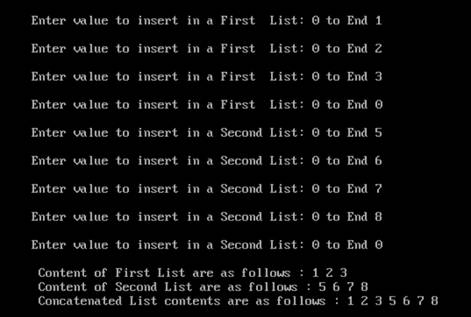
Program plan:
- Item, start variablesare used for input. There is structure listnode having data, nextPtr member variables which represents the linked list node.
- void insert(node **head, int value) function inserts the node in the a linked list.
- node *concat(node *flist, node *slist) function concat the two linked list and return the resultant linked list.
- void printList(node *head) function display the contents of the linked list.
Program description:
The main purpose of the program is to perform the concatenation of two linked list by implanting the concept which is same as strcat() function of string.
Explanation of Solution
Program:
#include <stdio.h>
#include <conio.h>
#include <alloc.h>
#include <ctype.h>
//structure of node of the linked list
typedefstruct listnode
{
int data;
struct listnode *nextPtr;
} node;
//function to insert a node in a linked list
void insert(node &head,int value);
//recursive function to concate the linked list
node *concat(node *flist, node *slist);
//function to print the content of linked list
void printList(node *head);
//main starts here
void main()
{
int item;
node *flist,*slist;
clrscr();
//initialization of start node of linked list
flist =NULL;
slist =NULL;
//loop to getting input from the user for first linked list
while(1)
{
printf("\nEnter value to insert in a First List: 0 to End ");
scanf("%d",&item);
//check condition to terminate while loop
if(item ==0)
break;
//insert value in a linked list
insert(&flist, item);
}
//loop to getting input from the user for second linked list
while(1)
{
printf("\nEnter value to insert in a Second List: 0 to End ");
scanf("%d",&item);
//check condition to terminate while loop
if(item ==0)
break;
//insert value in a linked list
insert(&slist, item);
}
// print the contents of linked list
printf("\n Content of First List are as follows : ");
printList(flist);
// print the contents of linked list
printf("\n Content of Second List are as follows : ");
printList(slist);
//call the function to reverse the linked list
// and store the address of first node
flist = concat(flist, slist);
//print the contents of concated list
printf("\n Concatenated List contents are as follows : ");
printList(flist);
getch();
}
//function definition to insert node in a linked list
void insert(node &head,int value)
{
node *ptr,*tempnode;
//memory allocation for the new node
ptr = malloc(sizeof(node));
//copy the value to the new node
ptr->data = value;
//set node's pointer to NULL
ptr->nextPtr =NULL;
//if the list is empty
if(*head ==NULL)
//make the first node
*head = ptr;
else
{
//copy the address of first node
tempnode =*head;
//traverse the list using loop until it reaches
//to the last node
while(tempnode->nextPtr !=NULL)
tempnode = tempnode->nextPtr;
//make the new node as last node
tempnode->nextPtr = ptr;
}
}
//function defintion to concat the list
node *concat(node *flist, node *slist)
{
node *ptr;
//check if list is empty
if(flist ==NULL|| slist ==NULL)
{
printf("\none of the lists is empty");
//return the node
returnNULL;
}
else
{
//store first node address
ptr = flist;
//traverse list until last node is not encountered
while(ptr->nextPtr !=NULL)
ptr = ptr->nextPtr;
//store the address of first node of second list
ptr->nextPtr = slist;
}
//return new list
return flist;
}
//function definition to display linked list contents
void printList(node *head)
{
node *ptr;
//stores the address of first node
ptr = head;
//traverse the list until it reaches to the NULL
while(ptr !=NULL)
{
//print the content of current node
printf("%d ", ptr->data);
//goto the next node
ptr = ptr->nextPtr;
}
}
Explanation:In the above code, a structure is created which represents the node of the linked list. Two starting nodes are initialized which contains the address of first node of each list. User is asked to enter the values for first linked list and linked list is created using insert() function by passing the starting pointer and value. This process is repeated to create the second linked list. printList() function is used to display the contents of both lists. Both lists are concatenated using the concat() function by passing the both list. In this function first list is traversed up to last node and then last node pointer points to the first node of second list. Starting node address is returned and stored in the pointer. Finally, concatenated list is displayed using printList() function.
Sample output:

Want to see more full solutions like this?
Chapter 12 Solutions
EBK C HOW TO PROGRAM
- In a shopping cart, there are various items, which can either belong to the category of household items or electronic items. The following UML diagram illustrates the relationship between items, household items, and electronic items. //Implementation Class public class ShoppingCart{ public static void main(String[] args){ final int MAX_ITEM = 50; Item cart = new Item[MAX_ITEM]; addItem(cart); // populate the item array printItem(cart); } } Considering that all the data definition classes and the implementation class are complete, which of the following Object-Oriented Programming (OOP) concepts do you need to use in the above context? i) Polymorphism ii) Method Overloading iii) Method Overriding iv) Dynamic Binding v) Abstract Class Explain, using course terminology, how you would use any of the above concepts to model the given scenario.arrow_forwardAnswer this JAVA OOP question below: An Employee has a name, employee ID, and department. An Employee object must be created with all its attributes. The UML diagram is provided below: - name: String - employeeId: String - department: String + Employee(name: String, employeeId: String, department: String) + setName(name: String): void + setEmployeeId(employeeId: String): void + setDepartment(department: String): void + getName(): String + getEmployeeId(): String + getDepartment(): String + toString(): String A faculty is an Employee with an additional field String field: rank public class TestImplementation{ public static void main(String[] args){ Employee[] allEmployee = new Employee[100]; // create an employee object with name Tom Evan, employee ID 001 and department IST and store it in allEmployee // create a faculty object with name Adam Scott, employee ID 002, department IST and rank Professor and store it in allEmployee } }arrow_forwardPlease answer this JAVA OOP question that is given below: An Employee has a name, employee ID, and department. An Employee object must be created with all its attributes. The UML diagram is provided below: - name: String - employeeId: String - department: String + Employee(name: String, employeeId: String, department: String) + setName(name: String): void + setEmployeeId(employeeId: String): void + setDepartment(department: String): void + getName(): String + getEmployeeId(): String + getDepartment(): String + toString(): String A faculty is an Employee with an additional field String field: rank Assuming the Employee class is fully implemented, define a Professor class in Java with the following: A toString() method that includes both the inherited attributes and the specializationarrow_forward
- Please answer JAVA OOP question below: An Employee has a name, employee ID, and department. An Employee object must be created with all its attributes. The UML diagram is provided below: - name: String - employeeId: String - department: String + Employee(name: String, employeeId: String, department: String) + setName(name: String): void + setEmployeeId(employeeId: String): void + setDepartment(department: String): void + getName(): String + getEmployeeId(): String + getDepartment(): String + toString(): String A faculty is an Employee with an additional field String field: rank Assuming the Employee class is fully implemented, define a Professor class in Java with the following: Instance variable(s) A Constructorarrow_forwardDevelop a C++ program that execute the operation as stated by TM for addition of two binary numbers (see attached image). Your code should receive two binary numbers and output the resulting sum (also in binary). Make sure your code mimics the TM operations (dealing with the binary numbers as a string of characters 1 and 0, and following the logic to increase the first number and decreasing the second one. Try your TM for the following examples: 1101 and 101, resulting 10010; and 1101 and 11, resulting 10000.arrow_forwardI need to define and discuss the uses of one monitoring or troubleshooting tool in Windows Server 2019. thank youarrow_forward
- I would likr toget help with the following concepts: - Windows Server features - Windows Server versus Windows 10 used as a client-server networkarrow_forwardI need to define and discuss the uses of one monitoring or troubleshooting tool in Windows Server 2019. thank youarrow_forwardWhy is planning for the retirement system and transition critical?arrow_forward
 C++ for Engineers and ScientistsComputer ScienceISBN:9781133187844Author:Bronson, Gary J.Publisher:Course Technology Ptr
C++ for Engineers and ScientistsComputer ScienceISBN:9781133187844Author:Bronson, Gary J.Publisher:Course Technology Ptr C++ Programming: From Problem Analysis to Program...Computer ScienceISBN:9781337102087Author:D. S. MalikPublisher:Cengage Learning
C++ Programming: From Problem Analysis to Program...Computer ScienceISBN:9781337102087Author:D. S. MalikPublisher:Cengage Learning Systems ArchitectureComputer ScienceISBN:9781305080195Author:Stephen D. BurdPublisher:Cengage Learning
Systems ArchitectureComputer ScienceISBN:9781305080195Author:Stephen D. BurdPublisher:Cengage Learning- Programming Logic & Design ComprehensiveComputer ScienceISBN:9781337669405Author:FARRELLPublisher:Cengage
 New Perspectives on HTML5, CSS3, and JavaScriptComputer ScienceISBN:9781305503922Author:Patrick M. CareyPublisher:Cengage Learning
New Perspectives on HTML5, CSS3, and JavaScriptComputer ScienceISBN:9781305503922Author:Patrick M. CareyPublisher:Cengage Learning




